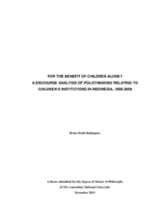Demographic Data
|
Sources: World Bank, UNICEF, UNDP HDR 2015, DHS 2011 |
Displaying 11071 - 11080 of 14390
In Cambodia's booming orphanage industry, children have become money-making tourist attractions, and it is suspected that sexual abuse is common in residential centres where there are few checks to identify child abusers among foreign volunteers.
Retrak has released a literature review on independent living programmes in an effort to understand the needs of young people coming of age on the streets.
The Independent Review Panel on UN Response to Allegations of Sexual Abuse by Foreign Military Forces in the Central African Republic released a report detailing the United Nations' "gross institutional failure" to act on allegations that Fre
To better understand the impact of donor funding, Lumos is conducting a five-part research study to examine the role of donors across a variety of sectors in propagating, supporting or ending the institutionalization of children. This report on US government funding is the first in the series.
Published jointly with UNICEF, this new BCN Working Paper focuses on the role of gatekeeping in strengthening family-based care and reforming alternative care systems. This Working Paper reviews different approaches to gatekeeping in five countries--Brazil, Bulgaria, Indonesia, Moldova, and Rwanda--to consider what has and has not worked, to analyze lessons learned from practice, and to reflect on the implications for improving policy and programs in this area.
This short video entitled "The Village" documents the work that Care for Children has done in Luquan, Kunming in China to help transition children away from orphanages and into families. Fifty three families from the village in Luquan have taken in 166 orphans--almost all of whom have physical or mental disabilities--from the Kunming orphanage. These children are now living with families and receiving the love and contact they had not previously received in the orphanage.
This thesis by Brian Babington, submitted for the degree of Doctor of Philosophy of The Australian National University, uses a discourse analysis methodology to shed light on deinstitutionalisation policymaking in Indonesia. In examining the factors that led Indonesia to adopt a policy to reduce reliance on the panti asuhan type of children's institution, the dissertation reveals that Indonesia appears to have adopted this policy change not primarily as a result of concern for children's rights, but rather because of political, economic, cultural, and religious factors. It also explores how the policy shift attempted to appease both pro-reform and pro-panti asuhan groups.
This article discusses a new set of standards for orphanages that the Cambodian Ministry of Social Affairs plans to begin enforcing. The new standards (known as the sub-decree on the management of residential care centers) are part of an effort to move towards family- and community-based care rather than institutionalization.
In this short video, BBC News interviews Gramboute Ibrahima, a local social worker who helps child trafficking victims in Abengourou, Ivory Coast. His organisation, CREER, has opened the region's first centre to help rehabilitate trafficked children. Almost every country in the world is affected by human trafficking. Children are particularly at risk, often sold across borders to work in brothels or on farms.
While data indicates that the use of corporal punishment by schools has declined significantly in recent years, the practice is still in use for tens of thousands of public school students in the United States. Many activists and parent groups are demanding that the practice be outlawed in schools.




